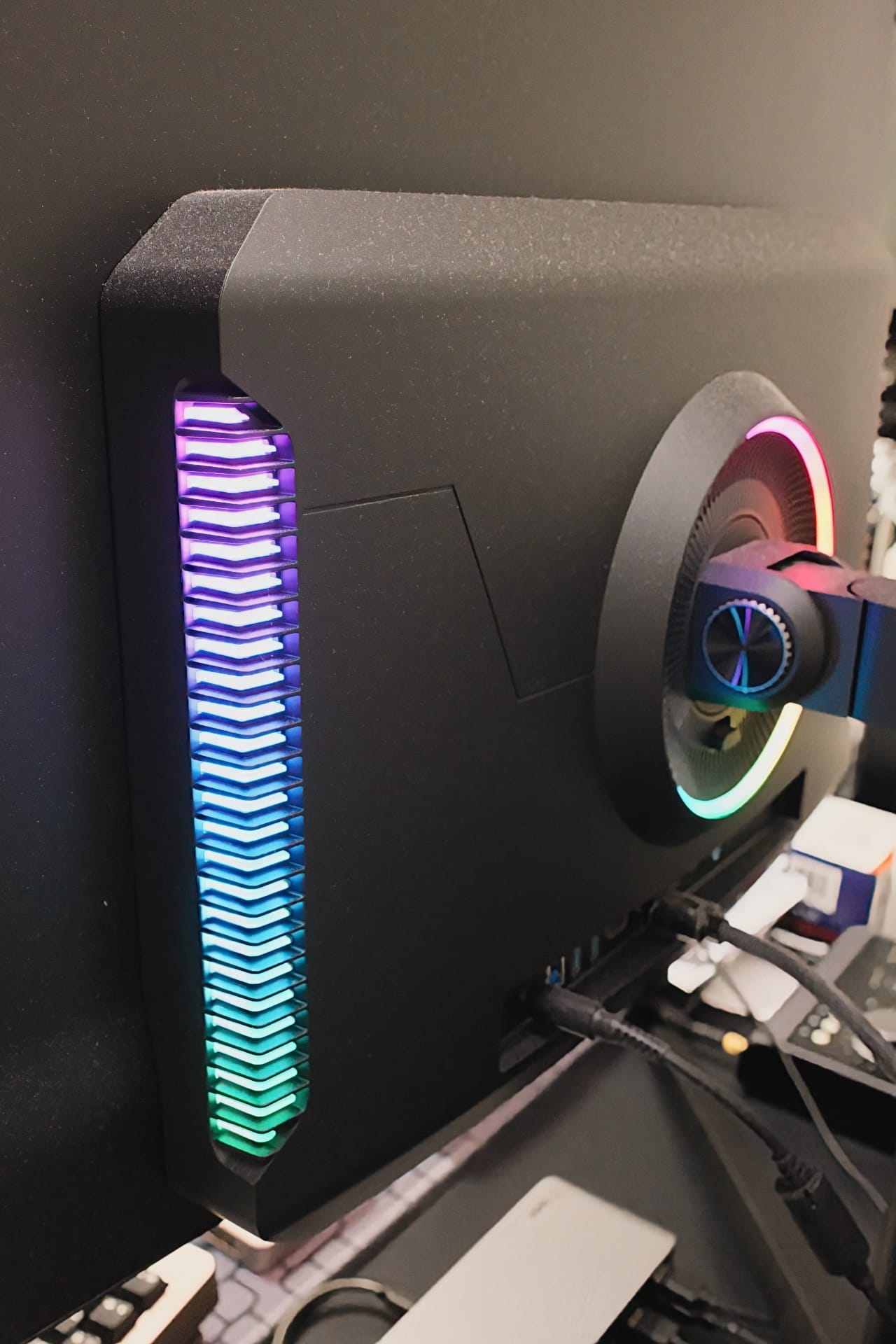Prism+ 32G1X Ultra review: Big specs, small budget — but where’s the catch?
A 32-inch, 4K, 240Hz QD-OLED gaming monitor for under SGD 1,400 sounds like marketing fiction.
But the PRISM+ 32G1X Ultra is very real — and very ambitious. It’s fast, it’s sharp, it’s vivid — and it’s nearly half the price of some competitors using the same panel, with one notable exception (more on that later).
But high-spec doesn’t always mean high-quality, and this has always been the sticking point for the brand’s critics. For those chasing value, it has become game of whether PRISM+ got the trade offs right — what to keep and what to skip.
Design & build: simple, functional, curved
The 32G1X Ultra follows PRISM+ convention: matte black finish, minimalist aesthetics. The stand is functional and supports height, swivel and tilt adjustments. The rear RGB lighting (Aura RGB) adds a bit of flair if you’re into desk glow, and you get a few customisation options. Materials feel adequate; far from luxurious, but fair for the price. I tried out the built-in speakers for five seconds to confirm my hypothesis — yep, pretty much.
You do get VESA mounting (75×75mm), which is helpful, especially if you plan to use a monitor arm. Just don’t expect refined ergonomics and extras — there’s a cable loop and that’s about it.
Specs & performance: high-end ambition
Here’s the main sell: a curved (1700R) 32-inch QD-OLED panel, 4K resolution, 240Hz refresh rate, and an advertised 0.03ms response time. These are elite specs — the kind you’d expect from a flagship ASUS, Alienware, or MSI model at SGD 2,000 or more.
Black levels are deep, as expected from OLED. Colours are rich and saturated, with DCI-P3 coverage around 110% and sRGB of 145%. PRISM+ rates the display HDR400 True Black, with peak brightness of 1,000 nits. For most desktop use, it’s plenty unless you’re working with direct sunlight behind you.
In gaming, the panel delivers. Motion clarity is superb; whether you’re playing Apex or Cyberpunk, the visual punch is there. Adaptive Sync support (G-SYNC Compatible, FreeSync) helps eliminate tearing, and the panel generally holds frame pacing well even in high-refresh conditions. It also comes with gaming assists like crosshair overlays and additional picture enhancements to improve in-game visibility.
The curvature is subtle. Unless you’re sitting close, it doesn’t add much immersion, though it may distort lines slightly if you’re working on graphics or layout. That said, 1700–1800R is about as mild as curved screens get.
OSD and usability: barebones but functional
Navigation is via a joystick that also serves as the action key. It works, but it’s fiddly and not particularly pleasant to use. On the flip side, the menu is clean and responsive — perhaps a little too clean. Many labels aren’t intuitive, and the manual doesn’t help. Fortunately, customer support provided supplemental documentation that helped clarify things a little more.
You get your basic presets (FPS, RPG, Movie, sRGB), plus brightness, contrast, sharpness, gamma and colour temp sliders. For general use, I left it on HDR Auto, though this disables certain display setting adjustments.
Being OLED, the burn-in anxiety is real. Being OLED, there’s always burn-in anxiety. But PRISM+ includes basic mitigation: Low Power Consumption mode, pixel shift, static image detection (taskbar, icons), and auto screen dimming. It’s enough for peace of mind for typical use.
It’s quite well equipped, ports-wise: USB-C 3.1 (65W Power Delivery), DisplayPort 1.4, two HDMI 2.1 ports, along with two USB-A 3.0 ports and one USB-B 3.0 port, which is solid. No eARC, which isn’t a huge loss as you’ll want better audio anyway. It does include a basic KVM switch, but I think you’re better off with wireless peripherals.
 Gaming, media and day-to-day use
Gaming, media and day-to-day use
This isn’t a monitor for those chasing perfection in one category. Instead, it’s perhaps the best OLED-equipped all-rounder at this price.
For starters, the 4K resolution gives you more than enough screen estate to work with. Multitasking is effortless — assuming your eyes can keep up. I had to lower the resolution slightly for comfort, but the flexibility is welcome. HDR content looks great. I didn’t feel the need to watch Netflix on my TV. Gaming is responsive, vibrant, immersive. It’s a serious upgrade if you’re coming from a flat 1080p or even a solid IPS panel. Is it twice as good for twice the price? Maybe not, but once you get used to OLED contrast, it’s hard to go back.
So, is there a better value alternative? No — but there is one in the same ballpark. Alienware’s AW3225QF (currently around S$1,599) uses the same 32-inch QD-OLED panel. Same resolution. Same refresh. Same 0.03ms response time. It does offer some niceties: Dolby Vision, official G-SYNC certification (not just compatibility), eARC support, and slightly more refined firmware. The AW3225QF is sometimes discounted, but the same could go for the 32G1X Ultra too. Moral of the story: keep a lookout for discounts for either.
Final thoughts: spec parity, price priority
The PRISM+ 32G1X Ultra is an excellent pick for casual users who want a premium display without chasing perfection.
It nails the essentials: 4K resolution, 240Hz refresh, deep contrast, and OLED fluidity. But you give up some polish, and the OSD is genuinely frustrating to navigate. Still, it delivers where it counts — and watching high-contrast content at your desk has never been better.
- PRISM+ 32G1X Ultra review - 7.5/107.5/10
PRISM+ 32G1X Ultra review
The Prism+ 32G1X Ultra packs an impressive spec sheet into a price point that seems almost too good to be true. It delivers fluid gaming, deep blacks, and rich colours thanks to its 32-inch 4K QD-OLED panel and 240Hz refresh rate. But you’ll need to live with some interface quirks and a barebones OSD. If you find it on sale, it’s one of the best-value OLED monitors on the market, if you don’t mind the trade-offs.

 Gaming, media and day-to-day use
Gaming, media and day-to-day use